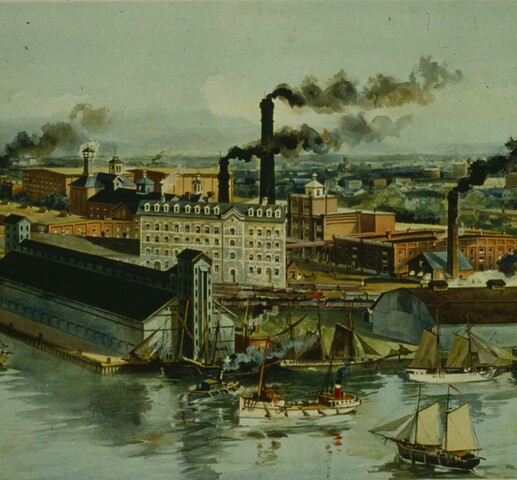
The Distillery District
Mill Street to the North, Cherry Street to the East, the Union Station Rail Corridor to the South, and Parliament Street to the West
Gooderham and Worts Distillery, circa 1800s. Image: City of Toronto Archives
Gooherham and Worts main building, containing Mill, Mashing and Fermenting departments, Toronto, November 1918. Image: City of Toronto Archives
Malt House, Distillery District, 2017. Image by Herman Custodio
Aerial view of Distillery District, Toronto, 2016. Image: Vik Pahwa
Mill Street to the North, Cherry Street to the East, the Union Station Rail Corridor to the South, and Parliament Street to the West
Developer: Cityscape Development
Built between 1859 and 1900, this collection of more than 40 buildings forms the Gooderham and Worts Distillery, once the largest operation of its type in North America. Established by brothers-in-law James Worts and William Gooderham, the distillery began with a 70-foot windmill, constructed on the edge of the bay in 1832. Following Worts untimely death in 1834, Gooderham carried the business forward, commissioning architects David Roberts and David Roberts Jr. to design many of the buildings in the complex. Gooderham and Worts continued to operate into the 20th century before being acquired by Hiram Walker in 1927. The last alcohol flowed from the original distillery in 1990.
In 2001, a team led by John Berman, Jamie Goad, David Jackson, and Mathew Rosenblatt, purchased the five hectare parcel, with the intention of transforming it into a vibrant, industrious area of arts and culture, while respecting the industrial built heritage.
Cityscape Developments had, at one time, some 200 open permits covering their work. Working with heritage experts, modernizing elements installed from the 1950s onward were stripped away, exposing old brick and plaster. Vintage lumber was salvaged and transformed into new walls and furnishings for tenants. The adaptive reuse of over 350,000 square feet of heritage space within the district won the project accolades and several prizes, including Heritage Toronto’s 2015 Special Achievement Award.
